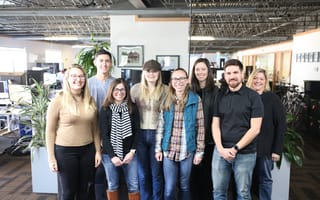When tasked with creating products that provide meaningful and relevant experiences to users, UX designers must consider usability and function, as well as design and branding. And the only way to check all those boxes is by getting as much input as possible from team members across the business.
“We ensure that our creative team remains truly cross-functional,” said Creative Director Daniel Braha of Colorado's Sovrn. “Designers, content strategists and marketers are involved in all of our projects.”
This practice, Braha said, ensures a plentitude of fresh perspectives and enables the design team to iterate quickly. We spoke with Braha and two other local design leaders who shared tips for scaling their UX process while staying true to their creative vision.

JumpCloud’s Directory-as-a-Service platform allows customers to unify their user identities, manage user access and secure network sign-in. Erica Wilhelmy, senior UX manager, said working across departments benefits their user-obsessed design strategy.
What processes, tools, methodologies, etc. were crucial in helping you scale your UX design process?
We advocated for hiring designers and researchers relative to our overall growth (and we’re still hiring). We kept the UX team centralized to ensure designers and researchers are supported, have a sense of community and are aligned around the experience we’re working to deliver. Meanwhile, we partnered with product management, engineering and marketing teams to create a structure where designers are embedded cross-functionally to work toward a clear business objective and solve problems for our customers. Designers bring their perspectives to their cross-functional teams while ensuring we’re creating a consistent experience.
We believe ideas come from anywhere.’’
As you scaled your UX design processes, how did you ensure team members still had the freedom to be creative and try new things?
With each designer at JumpCloud, we’ve maintained the tenet that creativity is key. We believe ideas come from anywhere. However, it is the designers’ skills that bring them to life. We introduced a design system that allows our designers to be more strategic and forward-thinking in their work and to tackle more complex problems. This is where designers are encouraged to think outside of the box and seek how they might design the whole experience rather than just a slice. They are challenged to contribute to the metrics, by which the success of the solution is measured.

For Principal UX Designer Mike Mencimer, success hinges on iteration.
Return Path from Validity helps businesses’ emails reach their intended audience, a feat that is more difficult than you might think, thanks to spam filters and provider barricades. Mencimer walked us through the team’s design process below, which relies heavily on being comfortable with the phrase, “try again.”
What processes, tools, methodologies, etc. were crucial in helping you scale your UX design process?
We’re a growing UX team on the smaller side at the moment, but we are putting processes into place that will help us scale up as our product and engineering teams grow. Those processes include a (home-brewed) style guide and component library for a single point of truth between designers and developers; weekly design reviews to encourage sharing our work and getting outside perspectives; heavy Slack communication for iterative feedback and gut-checks; and abstract for version control for designs and collaboration.
Each UX designer is responsible for one or more of our interlocking products.’’
As you scaled your UX design processes, how did you ensure team members still had the freedom to be creative and try new things?
Each UX designer is responsible for one or more of our interlocking products. They need to fully understand the data flowing through them and the type of persona that’s using them. With that autonomy comes a lot of freedom to work up the best user interfaces in a reciprocal alchemy of sorts with product managers and engineering leads.
In other words, we research, we learn, we draw, we bounce ideas off each other and we iterate. When a teammate or stakeholder tells us to “try again,” we review with our peers and we figure out a way to meet the product requirements. After we get the go-ahead, we launch and start the process over. Designers are asked to be creative and solve challenging product problems every day. It’s the best part of the job.

Sovrn helps creatives pursue their passions by taking care of the commerce, analytics and advertising side of the house for publishers and advertisers. We spoke to Creative Director Daniel Braha about why a cross-functional approach to design is crucial for building the best product possible.
What processes, tools, methodologies, etc. were crucial in helping you scale your UX design process?
First and foremost, it’s crucial we remember that our customers are real people. Our creative team takes an empathetic approach, focusing on human-centered design principles. We consider the motivations and goals of publishers and readers while we refine our incredibly complex products.
In terms of methodology, we follow an iterative design process. We use Sketch for layout and InVision for prototyping. Our design system is a custom set based on Google Material and our app is built in React. With this mindset and these tools, we’ve been able to maintain quality and reliability across our global services.
Our creative team takes an empathetic approach, focusing on human-centered design principles.’’
As you scaled your UX design processes, how did you ensure team members still had the freedom to be creative and try new things?
We ensure that our creative team remains truly cross-functional. Designers, content strategists and marketers are involved in all of our projects. By keeping an open dialogue, we can brainstorm, get fresh eyes on everything and iterate quickly.
Our team considers everything from a publisher's first moments with the website to the interactivity of setting up our products through the lifecycle of working with us. It’s important we don’t get tunnel vision or lose sight of our identity. We advocate for publishers because great publishers can change the world. It’s an honor to play a part in that.








